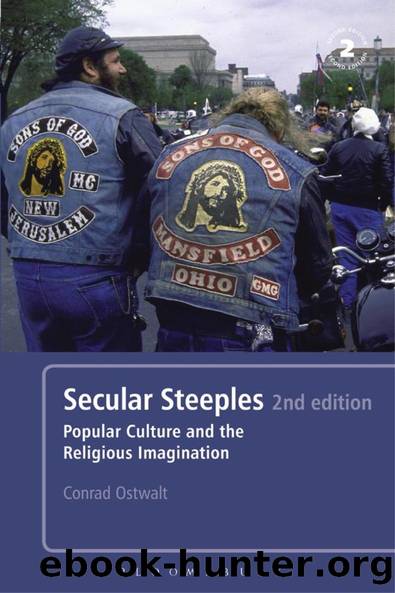Secular Steeples 2nd edition by Conrad Ostwalt

Author:Conrad Ostwalt [Ostwalt, Conrad]
Language: eng
Format: epub
Tags: Social Science, Popular Culture, Religion, Spirituality, Sociology of Religion, Christian Living, Spiritual Growth, Sociology, General
ISBN: 9781441123145
Google: 3y5NkeqDCigC
Publisher: A&C Black
Published: 2012-09-27T03:33:03+00:00
Religion, film, and secularization
The secularization thesis that forms the basis of this book is important to consider in light of film because film is the only cultural product studied here that is essentially a product of the postmodern world. As secularization is generally associated with Western culture since the Enlightenment, film is the only cultural form considered here with its entire history during the era when the secularization of Western culture has been at its height. This positions film uniquely to take over the functions religion is transferring to secular culture.
One of the major arguments underlying my work hinges on the idea that the secular and the religious worlds can coexist without religion becoming less significant. I am assuming that secularization does not destroy religion, and, for the purposes of this study, I am defining secularization as a sociological process that blurs the boundaries between the sacred and the secular. Western religion is based upon the idea of a transcendent God (a wholly and Holy Other) and on a sacred realm that is completely separate from our mundane, secular, profane world. This division of reality into sacred and profane has also characterized much religious studies work. But in the postmodern era, the strict boundaries separating sacred and profane have become flexible, and from these flexible boundaries we see secularization taking place in two directions.45 First, there is a tendency for tradition to secularizeâfor religious institutions to employ secular and popular cultural forms like television and the movies to make religious teachings relevant for a contemporary audience.46 In this instance, we see contemporary religion making concessions to secular cultural forms. The second way secularization is proceeding is by the dispersion of the religious sensibility through a variety of contemporary, secular cultural forms. As I argued in Screening the Sacred, when religious institutions no longer dominate culture they forfeit some of their proprietorship over sacred sensibilities. With this loss of cultural hegemony, religious concerns surface elsewhere, so that secular culture can function religiously. In postmodern society, the religious impulse is disseminated through a variety of cultural forms like film, which are external to traditional religious institutions and expressions.47
As I have written previously in Screening the Sacred, the result of this secularization is a postmodern society defined by a secular paradoxâa society that is uncomfortable with institutionalized and public religion but is often defined by religious categories through popular culture. As secularization of society continues, so does the dissipation of functions formerly reserved for religious institutions. We find popular culture functioning in some of the same ways as institutionalized religious ritual so that popular culture provides a context for understanding values, belief systems, and myths.48 To illustrate this, I will discuss how popular films have provided a secular context for understanding a traditional Western religious concept, the apocalypse, mirroring the two directions of secularization.
Download
This site does not store any files on its server. We only index and link to content provided by other sites. Please contact the content providers to delete copyright contents if any and email us, we'll remove relevant links or contents immediately.
Getting It, Then Getting Along by L. Reynolds Andiric(631)
Religion and Politics Beyond the Culture Wars : New Directions in a Divided America by Darren Dochuk(451)
Global Justice, Christology and Christian Ethics by Lisa Sowle Cahill(411)
Positive Psychology in Christian Perspective: Foundations, Concepts, and Applications by Charles Hackney(341)
Forgiveness and Christian Ethics by Unknown(329)
Douglas Hamp The First Six Days by Unknown(257)
The Horrors and Absurdities of Religion by Arthur Schopenhauer(243)
Insurgency, Counter-insurgency and Policing in Centre-West Mexico, 1926-1929 by Mark Lawrence(234)
Christian Martyrdom and Christian Violence by Matthew D. Lundberg;(223)
The Oxford Handbook of Greek and Roman Mythography by R. Scott Smith;Stephen M. Trzaskoma;(217)
Beyond Heaven and Earth by Gabriel Levy(210)
God and Eros by Patterson Colin;Sweeney Conor;(208)
The Bloomsbury Reader in Christian-Muslim Relations, 600-1500 by David Thomas;(205)
Autobiography, Volume 2: 1937-1960, Exile's Odyssey by Mircea Eliade(197)
Cult Trip by Anke Richter(194)
Witches: the history of a persecution by Nigel Cawthorne(192)
An Introduction to Kierkegaard by Peter Vardy(179)
The Global Repositioning of Japanese Religions by Ugo Dessi(173)
The Myth of Disenchantment by Jason A. Josephson-Storm(173)
